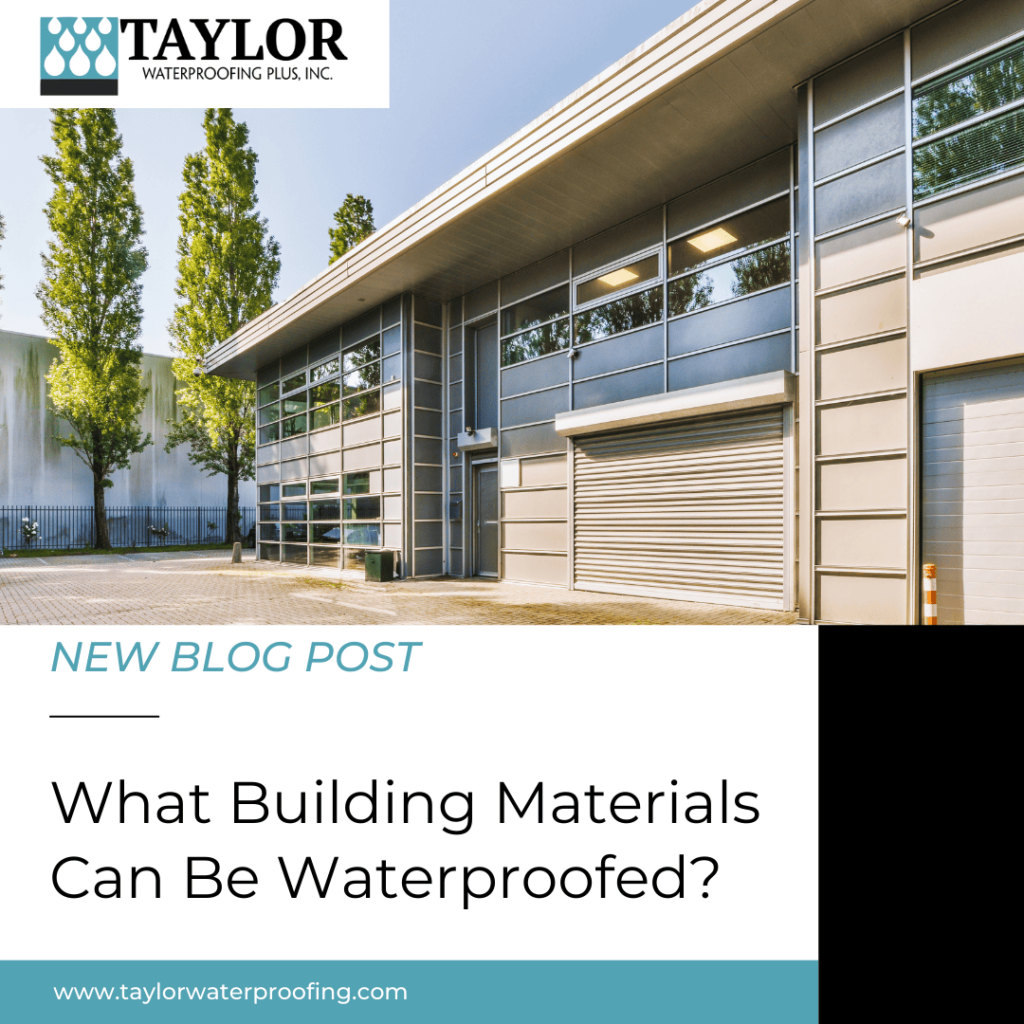
What Building Materials Can Be Waterproofed?
Water intrusion can be costly and cause extensive damage to your building. Failing to properly waterproof your building can lead to structural damage, odors, warped materials, and other issues. So, what building materials can actually be waterproofed? The answer: All of them! The waterproofing process for your building’s materials depends on the type of material and requires different techniques and supplies.
Concrete
Over time, water can seep into the pores in concrete. This can cause the concrete to crack and weaken. Water intrusion can also cause spalling, in which the surface of the concrete breaks and peels off, or efflorescence, which is a white salt deposit that leaves behind a chalky residue. Concrete can be waterproofed by applying a sealant or coating to the surface. For outdoor concrete that is used in a driveway or parking garage, penetrating sealants such as silane or siloxane are usually recommended. For concrete on the interior of your building, an acrylic, polyurethane, or epoxy sealant is usually used. Elastomeric coatings are often used for basements and foundations.
Steel & Metal
Without proper waterproofing, the metal and steel components in your building can rust and corrode, causing serious structural damage. Steel is often galvanized with a zinc coating to prevent rust. Silicone and polyurethane sealants can be used on metal joints and fasteners to prevent corrosion.
Brick
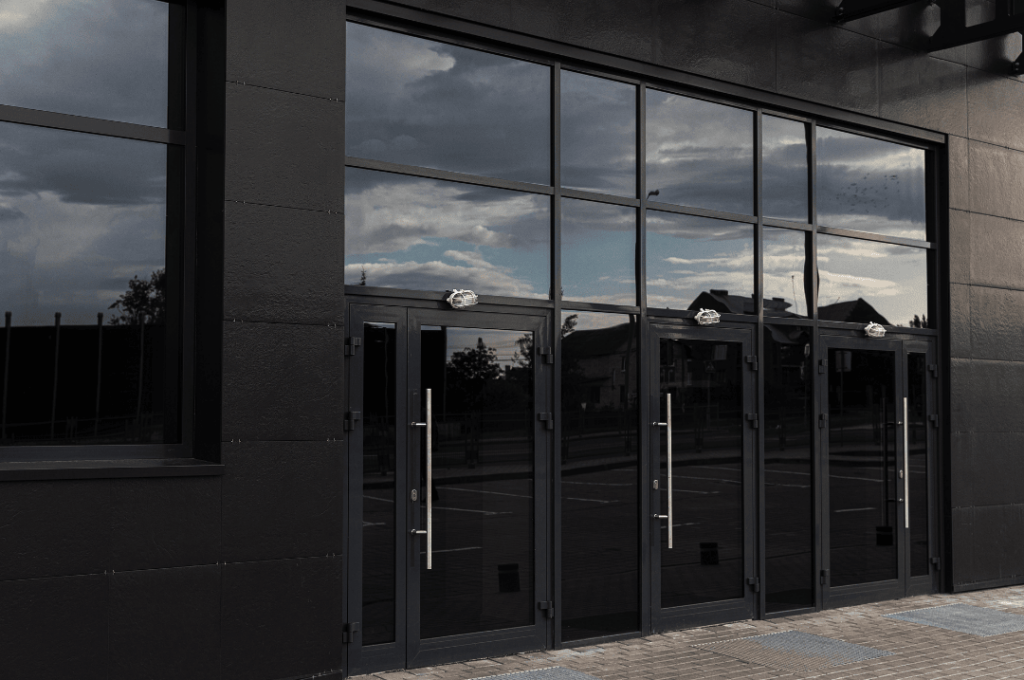
Brick and other masonry are building materials that can be porous and susceptible to water damage. Water can be absorbed into the brick, leading to freeze-thaw damage. Silane sealants are often used to create a water-repelling layer on brick walls. Siloxane sealants are often used for outdoor applications and penetrate the brick or masonry to create a long-term waterproof barrier.
No matter what you need waterproofed at your commercial property, our team of experts will ensure that your building materials are fully protected. Contact us through our website here or give us a call at 713-691-1430.
Check out our blog to learn more about our waterproofing services!
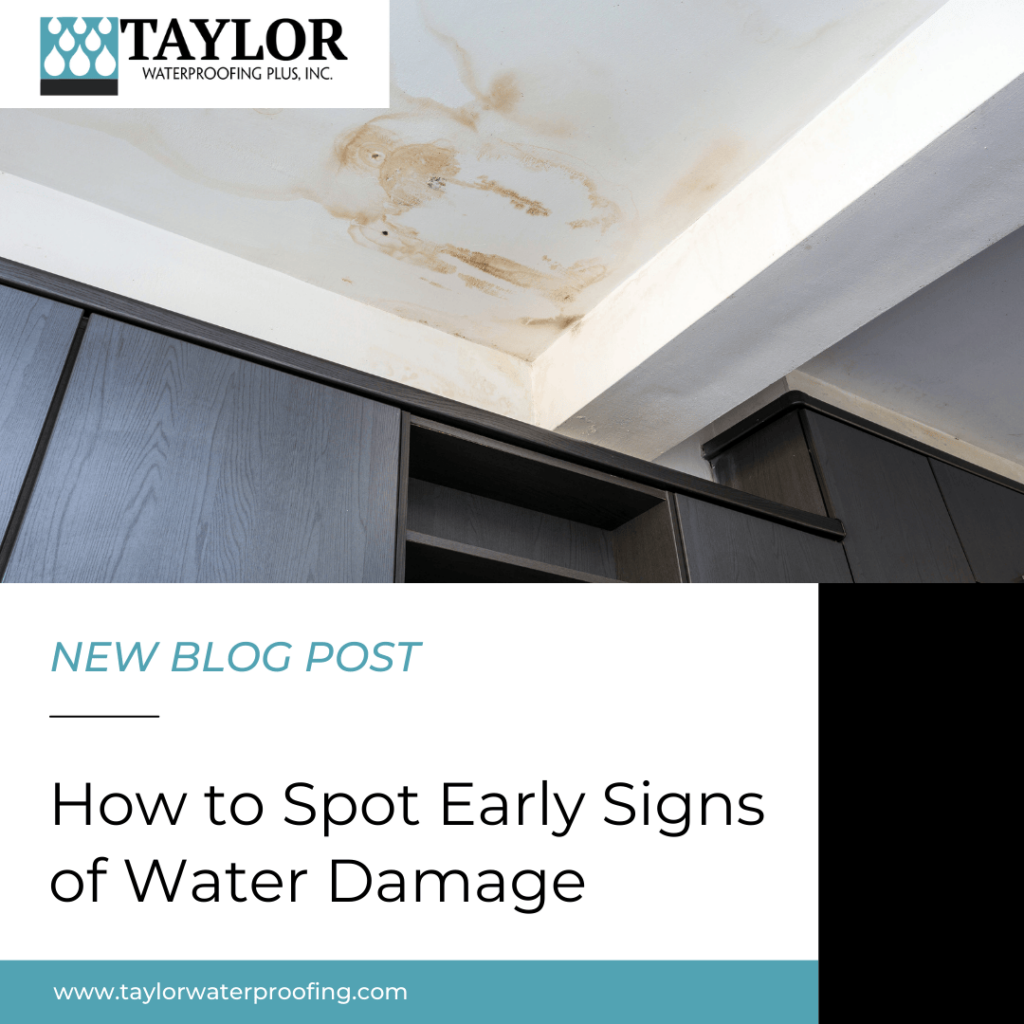
How to Spot Early Signs of Water Damage
It’s important to catch leaks and water damage early to prevent costly repairs. Water damage can affect commercial buildings in many ways. It can cause safety issues and compromise the structural integrity of the building. Identifying early signs of water damage, repairing the issue, and having a professional waterproofing company seal the area will protect your building and ensure long-term prevention.
Unexplained Stains
Water that is allowed to sit on your building’s materials will cause visible signs. This includes stains on the walls, ceilings, and floors. On brick or concrete, look for efflorescence, a white, powdery residue caused by water intrusion.
Warped Materials
Walls, floors, and ceilings can all warp because of water damage. As the water sits on the building’s materials, it can cause them to expand and buckle. This can be seen on hardwood and laminate floors, drywall, ceiling tiles, and around window frames.
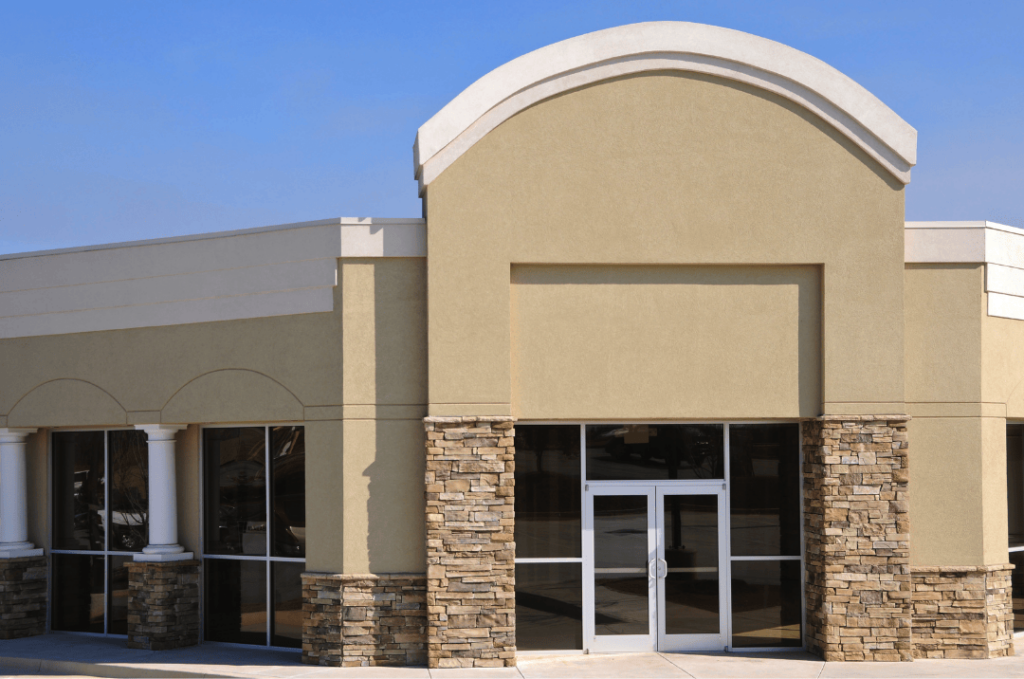
Musty Odors
When building materials absorb water and remain damp for extended periods, they can develop musty odors. This is usually accompanied by unexplained humidity or dampness. These odors can be a sign of water infiltration and lead to air quality issues.
Peeling Paint
One of the early signs of water damage is peeling paint. As water and moisture become trapped between the wall material and paint, it breaks down the paint, leading to bubbling and peeling.
Missing or Damaged Sealant or Coatings
It’s important to occasionally check your waterproofing systems. Many sealants and coatings are made to last for years, but eventually, they will need maintenance and replacement. Missing or damaged sealant can be a warning sign of water intrusion. Check around windows, doors, expansion joints, and other vulnerable areas to ensure the waterproofing membrane is intact.
The key to maintaining a waterproofed commercial building is detecting the early signs of water damage and putting the proper preventative measures in place. Recognizing the warning signs of water damage early can help you take action before costly repairs are needed. Contact us today to learn how we can help with your building’s waterproofing needs here or give us a call at 713-691-1430.
Check out our blog to learn more about our waterproofing services!
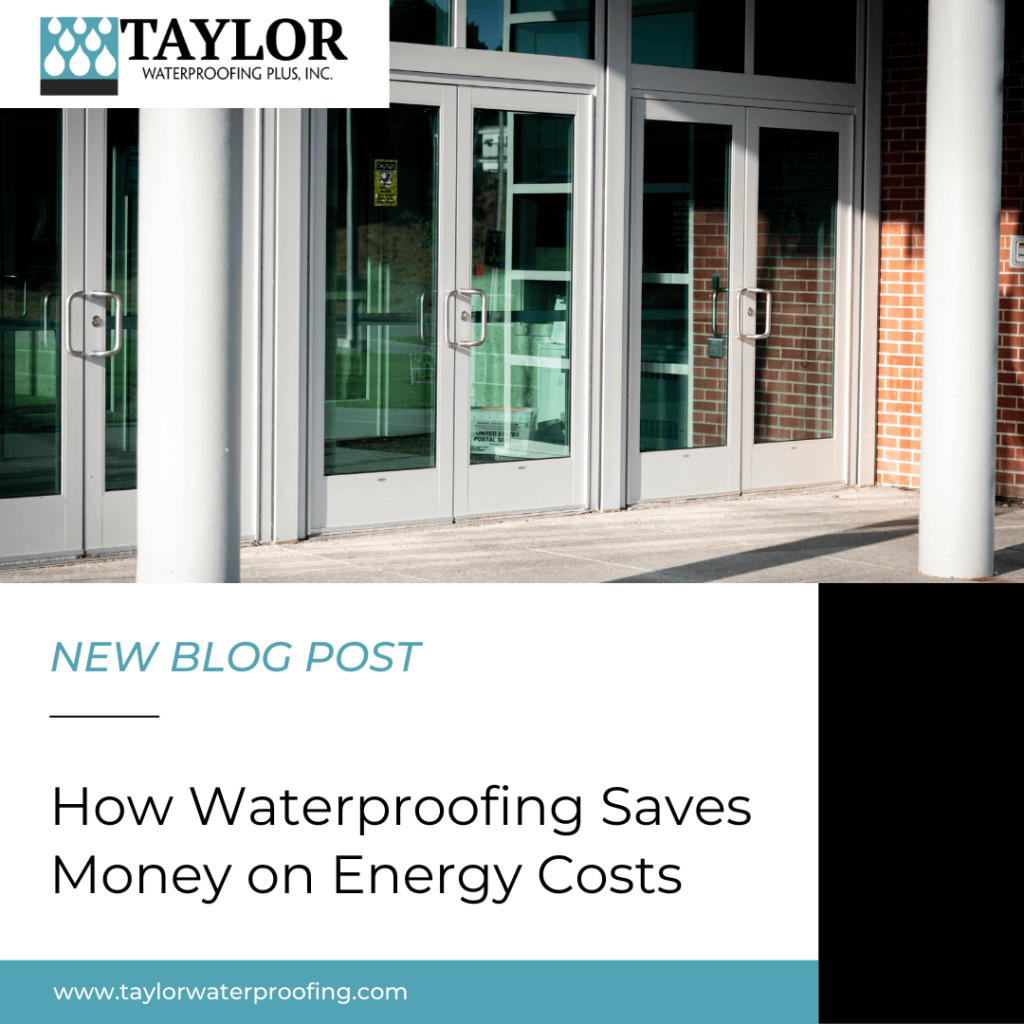
How Waterproofing Saves Money on Energy Costs
Waterproofing is more than just protecting your building from water intrusion. A huge benefit of waterproofing your building is that it saves money on energy costs. Leaks, cracks, and gaps lead to air leaks and insulation damage, forcing your HVAC system to work harder, and increasing energy bills. Sealants and coatings protect against rising temperatures in more ways than one.
Prevent Air Loss
Up to 30% of the energy loss in commercial buildings is due to air leakage. Air leakage can happen around doors, windows, expansion joints, cracks, and anywhere else in the building that has a leak. Sealants and coatings can be used around these areas to prevent air loss and keep the HVAC system from overworking.
Protect Insulation
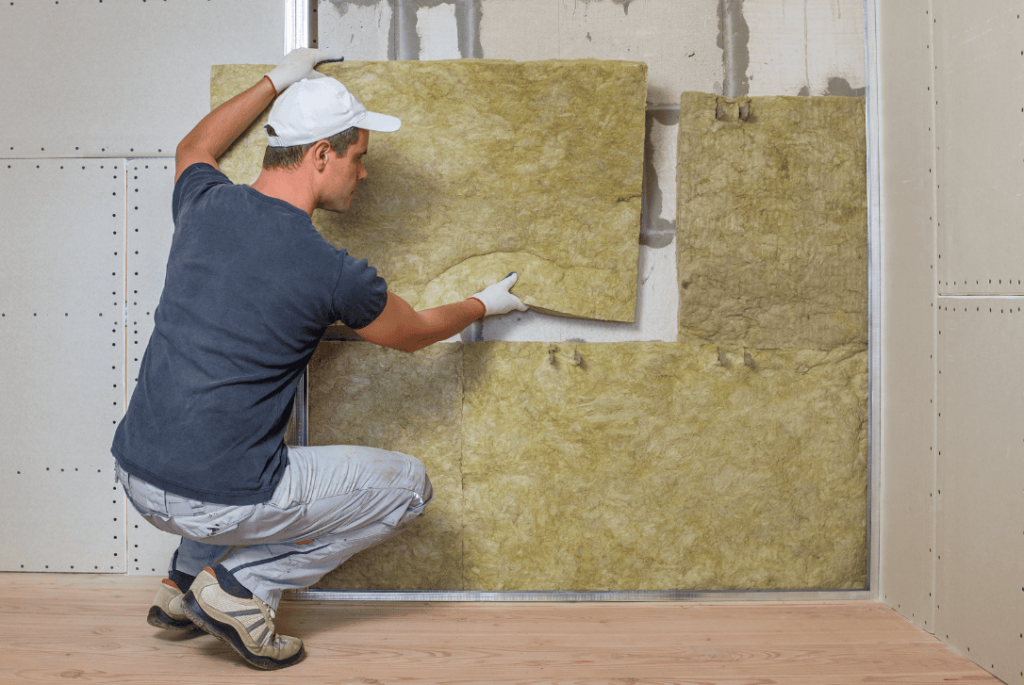
Insulation is used in the walls, between floors, in the roof, around the foundation, and in other areas of a commercial building. The job of insulation is to regulate the building’s temperature and reduce heat gain or loss, depending on the season. If insulation becomes wet, it loses a significant amount of its R-value. This is insulating capacity and ability to regulate temperature. By preventing leaks and water intrusion, you are preventing insulation damage and maintaining its effectiveness.
Combat Against Temperature Extremes
One thing that can overwork your HVAC system and cause your energy bills to jump up is extreme indoor temperature fluctuations. By creating waterproof barriers throughout your building, you’re creating stable indoor temperatures and reducing the strain on your heating and cooling systems.
Reduce Heat Absorption
UV-reflective coatings can be applied to your building’s exterior walls and help to reduce the amount of heat absorbed by the building. By reducing the amount of heat the building absorbs, the coatings keep the building cooler which leads to long-term cost savings.
Waterproofing does more than just protect your building from water damage. Your building’s energy efficiency and how well it is waterproofed are directly related. By sealing air leaks and creating waterproof membranes around key points in your building, you can lower energy costs. Contact us today to learn how we can help with your building’s energy efficiency here or give us a call at 713-691-1430.
Check out our blog to learn more about our waterproofing services!
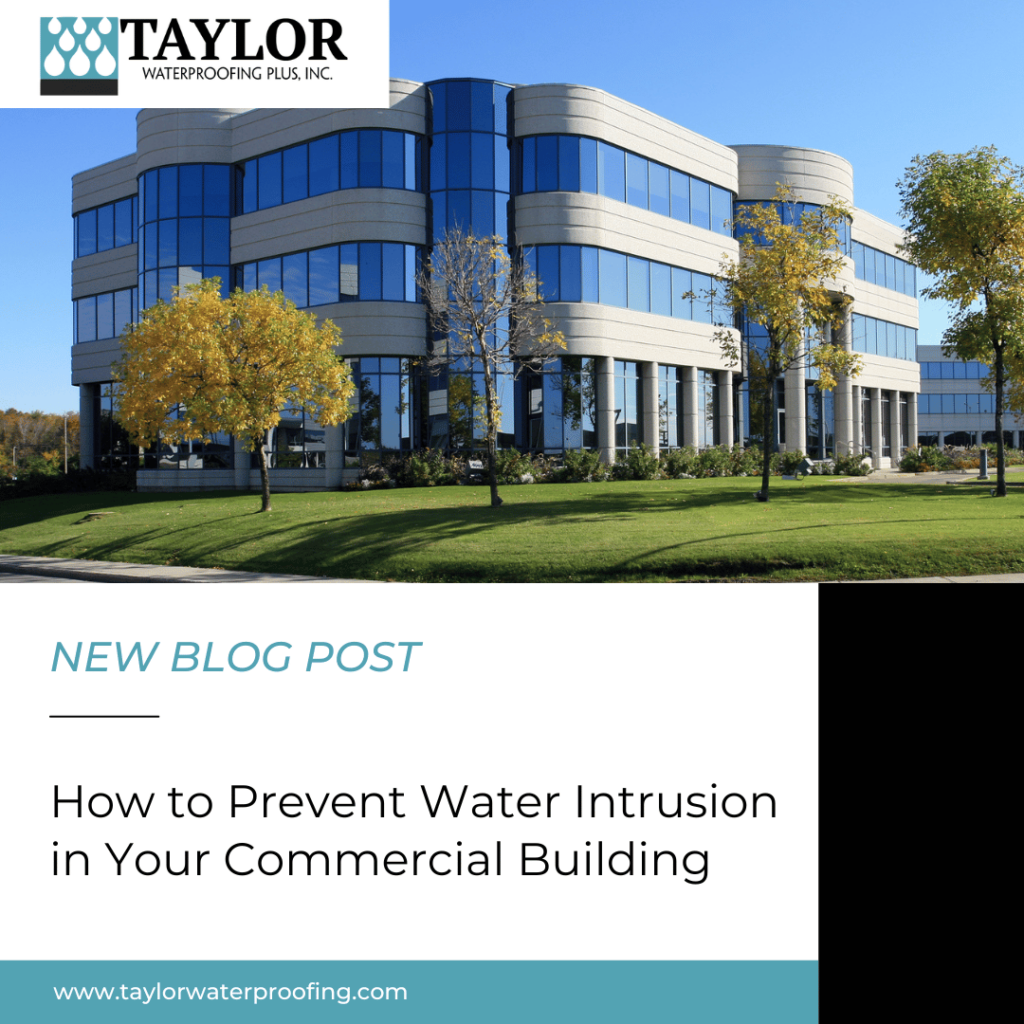
How to Prevent Water Intrusion in Your Commercial Building
Using preventive waterproofing measures before there is a leak will save you time and money. Damage caused by water intrusion can be costly and compromise your building’s structural integrity. Even small leaks can cause significant damage. The best way to prevent this damage is to be proactive and ensure your waterproofing systems are up-to-date and properly installed.
Water Damage in Commercial Buildings
Water intrusion can cause your building’s materials to break down and weaken, deteriorating your building over time. This can include metal elements starting to corrode, concrete cracking and chipping, paint peeling from walls, or, in extreme cases, the building’s structure failing. Water can also lead to water damage such as stains on walls, ceilings, and floors.
Common Causes of Water Intrusion
- Cracks That Developed Over Time
- Old or Damaged Waterproofing Membranes
- Improperly Installed Waterproofing Systems
Steps to Prevent Water Intrusion
Seal Windows and Doors – Gaps in windows and doors can allow water to seep into the interior of your building. This can stain and damage the walls and floors around the window or door. These areas should be checked regularly for worn weatherstripping or caulking. Our team can apply a sealant to the perimeter to ensure that your windows and doors are watertight.
Replace Sealant When Needed – Depending on the type of sealant used, it can last anywhere from 5 to 15 years. Although many commercial waterproofing sealants are extremely durable, they will degrade over time. Replacing waterproofing sealants when needed is an important step to ensuring your building is protected from water intrusion.
Seal Cracks in Concrete – Cracks are common in foundation and high-traffic areas. Cracks in concrete often act as entry points for water intrusion. These cracks can be filled with epoxy or polyurethane sealant or chemical grout injections for more extreme cracks.
Use Coatings and Sealants on Exterior Walls – Waterproof coatings and sealants can be applied to exterior walls as a first line of defense. These coatings and sealants can be customized to meet your specific needs and are available in various colors to complement your building’s design.
Our team can help with any of the above and more. We understand the importance of protecting your building from water intrusion and will help you take the right preventative measures.
Contact us today here or give us a call at 713-691-1430.
Check out our blog to learn more about our waterproofing services!
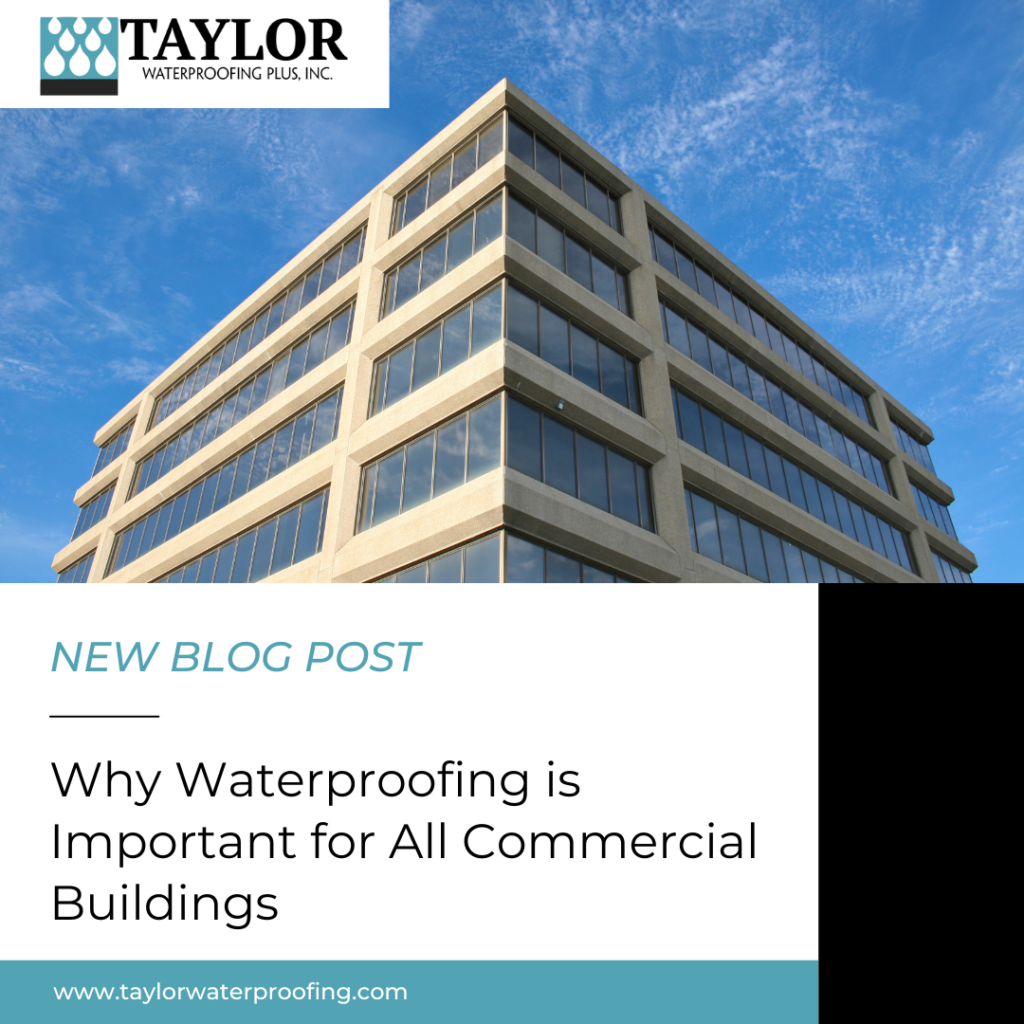
Why Waterproofing is Important for All Commercial Buildings
Waterproofing your commercial building creates a barrier to stop water from infiltrating the building. Water intrusion can corrode the steel in concrete, warp walls and flooring, cause cracks in the foundation, stain the building’s interior, and more. Adding preventative measures to your building is the best way to address the issues before they begin and protect your investment.
Problems Caused by Outdated or Poor Waterproofing Systems & Prevention Tips
Structural Issues: Over time, water exposure can cause the steel framework to rust and corrode, causing structural damage and potentially dangerous conditions. Water intrusion can also weaken and crack foundations and concrete in the basement.
How to Prevent: Applying sealants and coatings to the exterior walls and building joints will create a waterproof membrane. To protect the foundation, a sealant can be applied to the concrete slab to prevent water seepage.
______________________
Health Concerns: When water sits on building materials for an extended period of time, it can impact the air quality and cause musty odors. This can lead to respiratory issues and allergies for the building’s occupants.
How to Prevent: Creating a waterproof membrane using sealants where needed will help prevent these issues. It is also important to make any necessary repairs at the first sign of a leak such as pooling water on the floor or watermarks and stains on walls and ceilings.
______________________
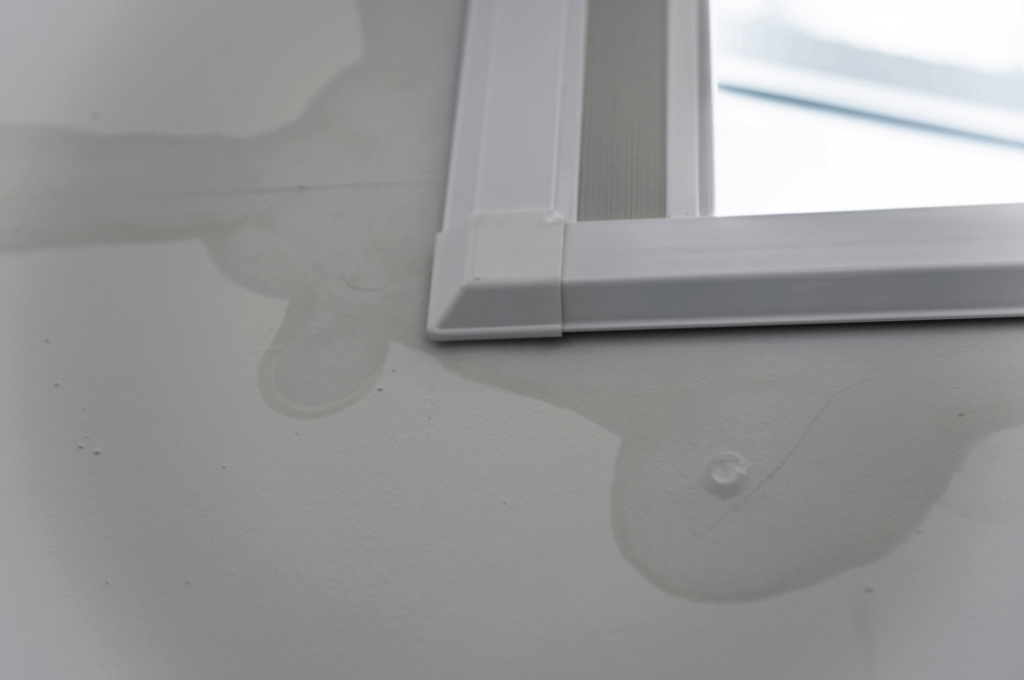
Weakening Building Materials: Waterproofing is important because it will reduce how many repairs you have to make. Water intrusion can weaken and corrode most building materials. Without proper waterproofing, your building is vulnerable to this damage.
How to Prevent: Have your waterproofing systems checked regularly and update as needed. Our team can address any issues such as cracks, leaks, and worn sealants.
______________________
Rising Energy Costs: Along with damaging your building’s materials and causing structural issues, leaks can lead to air leakage which results in your HVAC system working harder to cool the building. This increased strain on the system will result in rising utility bills.
How to Prevent: While this air leakage can happen anywhere in your building, it is common around windows, doors, and building joints. Checking and repairing weather stripping and sealants in these areas will help reduce air leakage.
______________________
More Spent on Repairs Long-Term: All of the issues above will lead to costly repairs over time. Minor leaks can turn into extensive damage that can require you to replace walls, concrete, flooring, and other materials.
How to Prevent: Waterproofing is important because it will save you money and protect your building. Investing in waterproofing solutions will prevent water intrusion before it causes damage.
To learn more about waterproofing solutions and how our team can help protect your building, contact us today here, or give us a call at 713-691-1430.
Check out our blog to learn more about our waterproofing services!
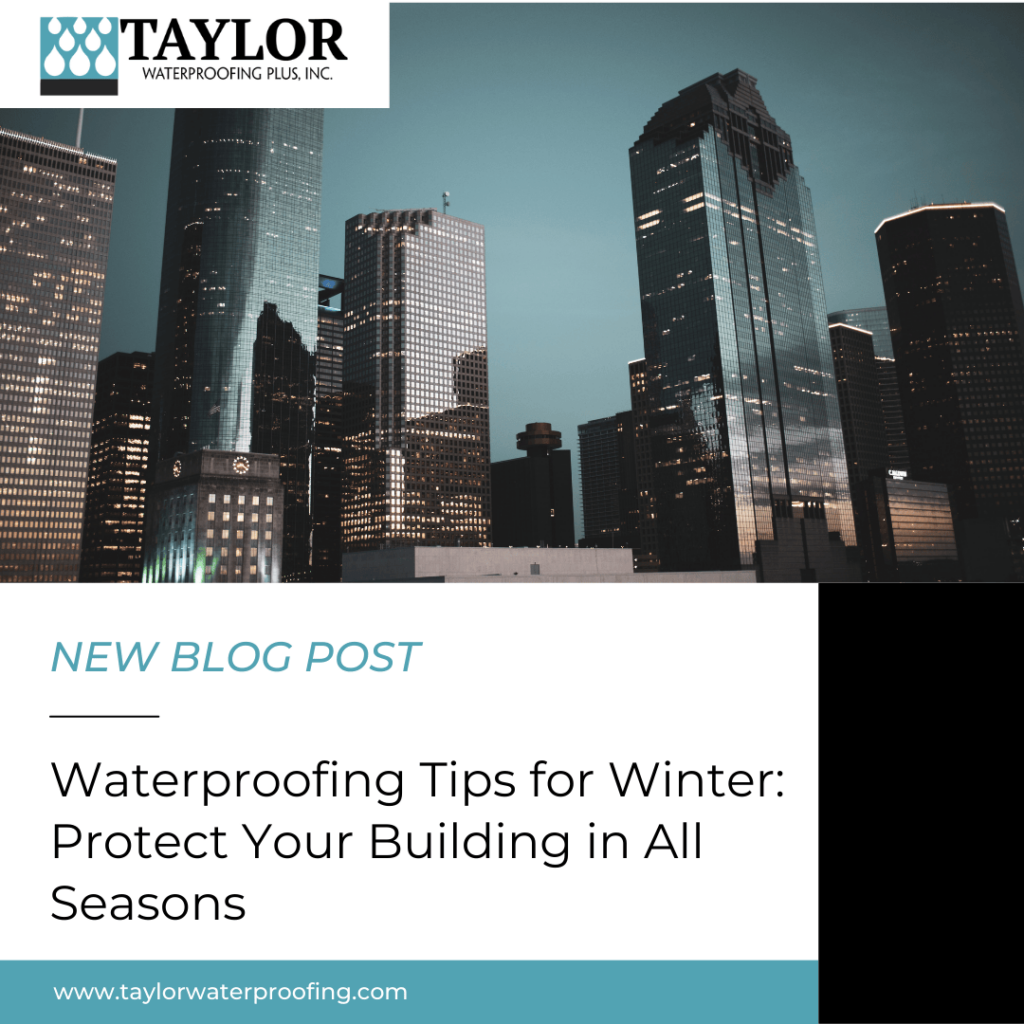
Waterproofing Tips for Winter: Protect Your Building in All Seasons
Although Houston is categorized as a subtropical climate, there are occasional freezes that can cause damage to commercial buildings. The Houston humidity also sticks around all year, increasing the risk of water infiltration and weakening building materials. Proper and up-to-date waterproofing can protect your building from external factors that can cause leaks and water damage.
Importance of Waterproofing before Freezing Temps
If sealants are worn down or if the waterproofing system was not properly installed, water can seep into cracks and cause further damage by expanding once it freezes. This can happen in concrete slabs, the edges of windows and doors, foundations, and walls. Once the crack has been expanded, water intrusion can cause water damage, staining, structural issues, and more.
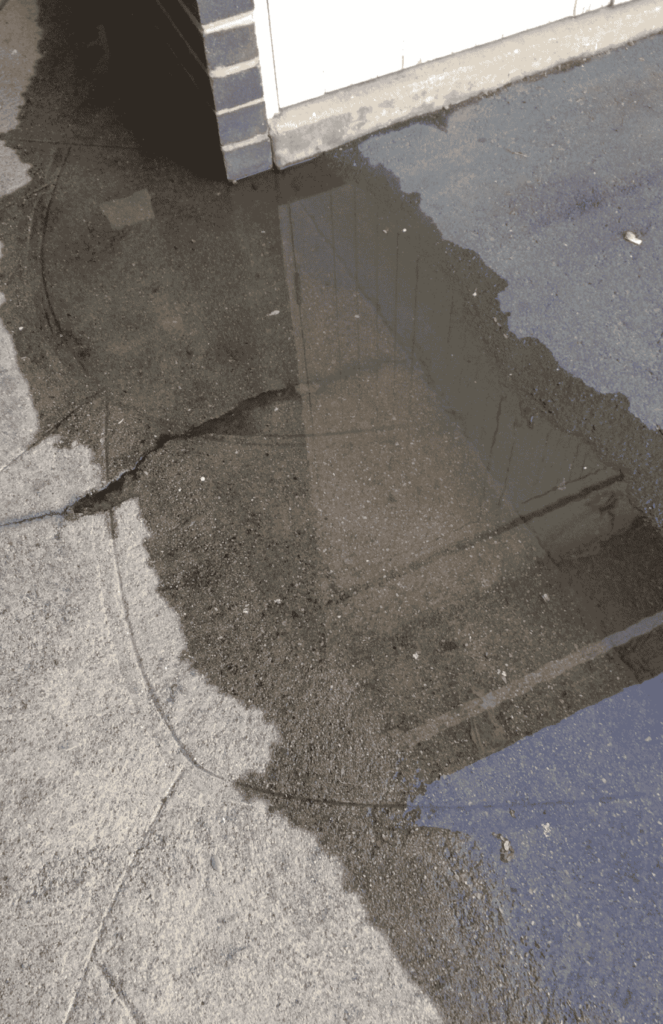
Effective Waterproofing Tips for Winter:
Check for Damage – A critical part of preparing your building is having regular waterproofing investigations performed. This will ensure that the proper waterproofing measures are in place and your building is ready to take on the winter.
Protect Walls – Because external walls are exposed to the elements, they are most susceptible to water freezing and expanding in cracks. Sealants and coating can be applied to the walls to protect them. There are many sealant and coating options available. Our team can help you decide which option is best for you based on your needs, building material, and desired look.
Prepping the Foundation – If your building’s foundation becomes damaged, it can cause cracks in the walls and structural issues. Because Houston is prone to heavy rain the soil is often saturated and can increase the chances of water or freeze damage if not properly waterproofed. Cracks in the concrete slab will need to be sealed and a sealant can be applied to the surface to prevent deterioration.
Repair & Protect Windows and Doors – Over time, the waterproofing systems around the edges of windows and door frames can wear down. This allows water intrusion and can lead to higher energy costs due to air leakage. Our team can take a look and replace any worn weather stripping, sealant, or coating to help prepare for the colder weather.
These waterproofing tips for the winter will not only protect your building this season but protect against the Houston humidity and rain all year round. Making sure your waterproofing systems are up to date and in good condition is important, especially during seasonal weather changes. Contact us today here or give us a call at 713-691-1430.
Check out our blog to learn more about our waterproofing services!
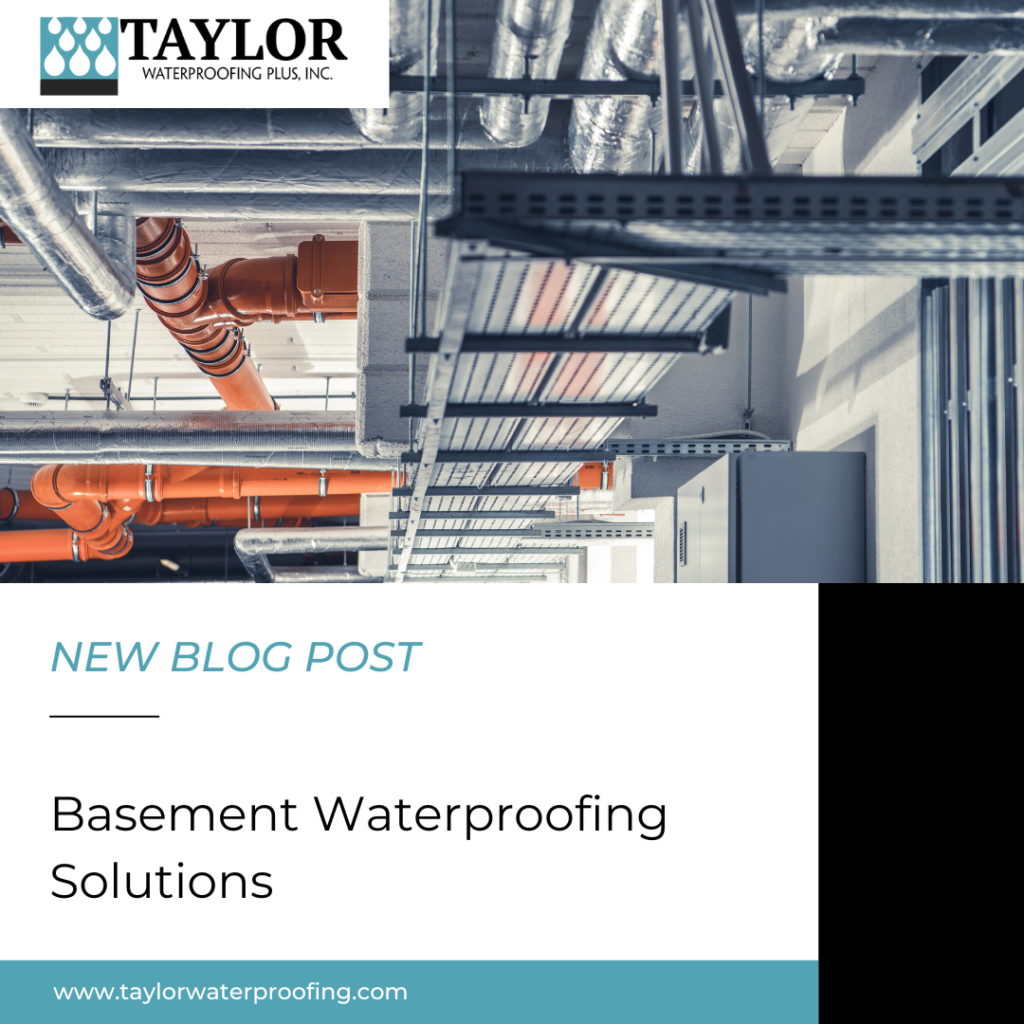
Basement Waterproofing Solutions
Basements are a common source of water infiltration and are particularly prone to flooding when heavy rain occurs. Water can easily seep into basements and cause major damage if not properly maintained and waterproofed. Taylor Waterproofing offers basement waterproofing solutions and can ensure that you get the full use of your investment in a commercial building, including the basement.

Below-Grade Waterproofing for Basements
An effective basement waterproofing solution uses a combination of exterior and interior waterproofing. This ensures that water does not infiltrate the basement and prevents water from getting trapped in the concrete of the foundation. Waterproofing should be considered in the construction process of a building to prevent damage from occurring later on, especially when a basement is included in the building.
Positive-side waterproofing can be done in the construction process to create a seamless, waterproof membrane. These are often polyurethane, epoxy, elastomeric, or asphalt-based sealants and coatings.
If an existing structure is having water infiltration due to age, wear and tear, or just needs an updated waterproofing system, negative-side waterproofing membranes are applied to the interior walls and floor of the basement. This adds an extra barrier and helps prevent water intrusion.
Taylor Waterproofing assesses projects before beginning work to determine what is the best course of action, but one specific product that our team uses is Professional Water Sealant. This specific sealant is a clear, penetrating, and breathable water repellant that is suitable for use on porous surfaces such as brick and concrete, making it a great strategy for preventing water infiltration in basements. This clear sealant is applied to basement walls to prevent moisture from building up in the room and helps keep the basement dry, ensuring the space is consistently available to be used.
Comprehensive Basement Waterproofing Solutions
Taylor Waterproofing’s team of professionals offers comprehensive basement waterproofing solutions and services to ensure that you get the most out of your investment in a commercial property. Water infiltration causes major disruptions to business operations and can be frustrating for all involved. Calling waterproofing experts during the construction process for preventative actions or at the first sign of water infiltration helps prevent further damage to your building. To speak with one of our team members about solutions for your building’s basement, contact us through our website here.
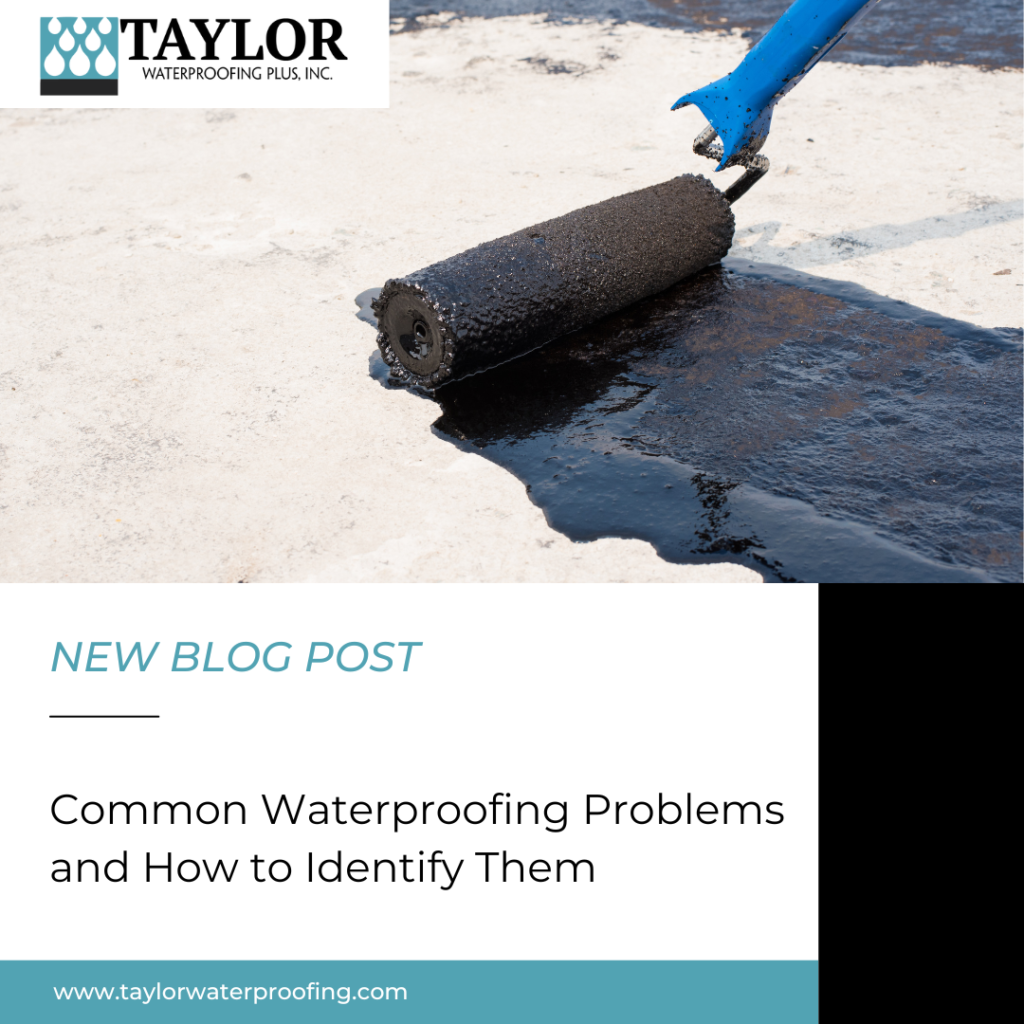
Common Waterproofing Problems and How to Identify Them
There are many common waterproofing problems that affect commercial properties, such as leaks, damaged sealant, and improperly sealed waterproofing solutions. Learning how to identify these problems is crucial to ensuring that damage does not go unnoticed, which could cause even more problems down the road. Below are tips for identifying common waterproofing problems and knowing when to bring in an expert.

Damaged Sealant
Sealant, like anything in a building, wears and tears with age. The sealant remaining intact plays an essential role in preventing water infiltration from locations such as windows and doors. Sealants have a long lifespan, but factors like extreme weather events can shorten this lifespan. Damaged sealants can be difficult to spot, so this is why general waterproofing investigations are important to verify the security of sealants on your building’s external walls and windows. However, major signs of damaged sealant are things such as water infiltration or water stains on walls. If sealant needs to be removed and replaced in your commercial building, our team is able to make recommendations for the best solution that will suit your building and provide the longest lifespan possible.
Damage and Cracks in Concrete
Damage to concrete is not always a sign that there may be a waterproofing problem in a building, but if it’s in a structure such as a parking garage, it’s a very likely cause. Parking garages are more exposed to the elements, so spalling or scaling in these structures is a common sign that water infiltration is to blame. These high-traffic areas need to be resurfaced with sealants more often than other surfaces due to their exposure to the elements and constant wear from vehicles. Reapplying coatings such as a polyurethane coating that can withstand wear from heavy-traffic areas is essential to preventing structural concrete damage.
Incorrect Waterproofing
It can be difficult to spot incorrect waterproofing techniques with an untrained eye, so this is why regular waterproofing investigations are important to protect your investment in a commercial building. Taylor Waterproofing offers waterproofing investigations, during which we will provide you with a detailed report of our assessment of your commercial building. These investigations can be vital to ensuring that your building is correctly waterproofed and protected from water infiltration. It can also help determine if sealant may need to be repaired or replaced if it’s been a few years since initial waterproofing was implemented for your building.
Waterproofing is an important component of protecting your investment in a commercial building and is not a step that should be skipped. By learning how to identify these common waterproofing problems, you can spot issues that may cause more damage if left unchecked. Our team can provide you with all of your commercial waterproofing needs. Learn more on our website and contact one of our team members about waterproofing for your building.
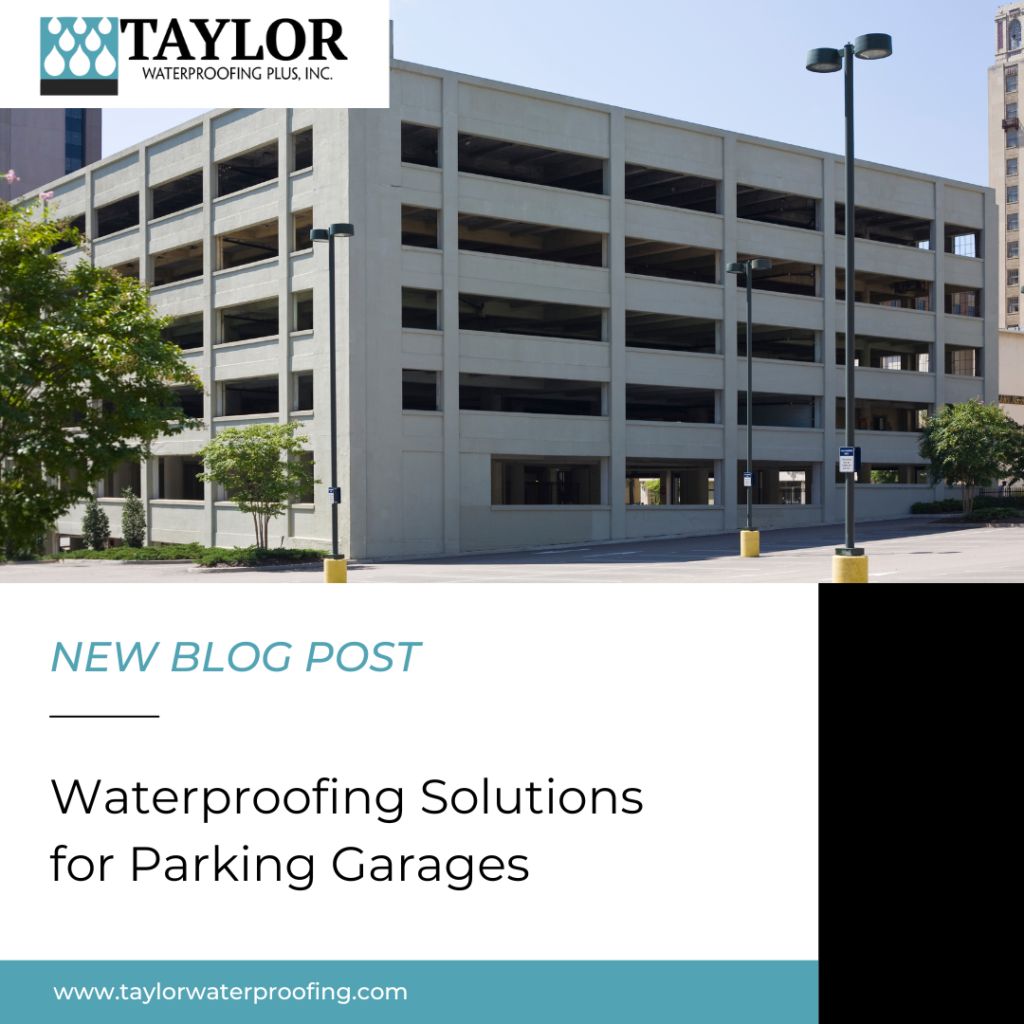
Waterproofing Solutions for Parking Garages
Parking garages are large structures that require a healthy amount of maintenance in all aspects, and prevention of water damage is no exception. Water damage can cause major damage to parking garages, but investing in waterproofing solutions protects your structure and ensures that it will be operating smoothly for years to come. Waterproofing a parking structure prevents structural damage to the concrete and allows you to fully utilize your investment by cutting out disruptions that could occur as a result of damage.
Parking Garage Deck Coating: Parking garages are constantly exposed to the elements, so waterproofing decks is important to ensure that water damage doesn’t occur. Water infiltration can occur in the concrete layer of a parking structure, causing cracks, spalling, scaling, and corrosion. Generally, sealants and coatings are used to provide a waterproof layer to parking garage decks, protecting them from water damage that could occur.
Parking Garage Expansion Joint Sealant: Expansion joints are vitally important in a parking garage, as they allow the concrete to shift as the temperature changes without causing cracks. Moisture infiltrating expansion joints can damage the concrete over time, leading to expensive repairs. Sealants provide a waterproof layer to expansion joints that prevent this from occurring and protect the parking structure.
Chemical Grout Injections: Chemical grout injections can be a cost-effective, long-lasting, and water-resistant method to seal cracks in parking structures. This mixture of polymer resins solidifies and prevents water from entering through small cracks, maintaining the structural integrity of the parking garage. Chemical grout injection is a great option for smaller cracks that may not need an entire sealant replacement.
Taylor Waterproofing’s experts have vast experience in waterproofing parking structures and will ensure that your investment is protected. To contact one of our team members about waterproofing solutions for your parking structure, contact us through our website here.
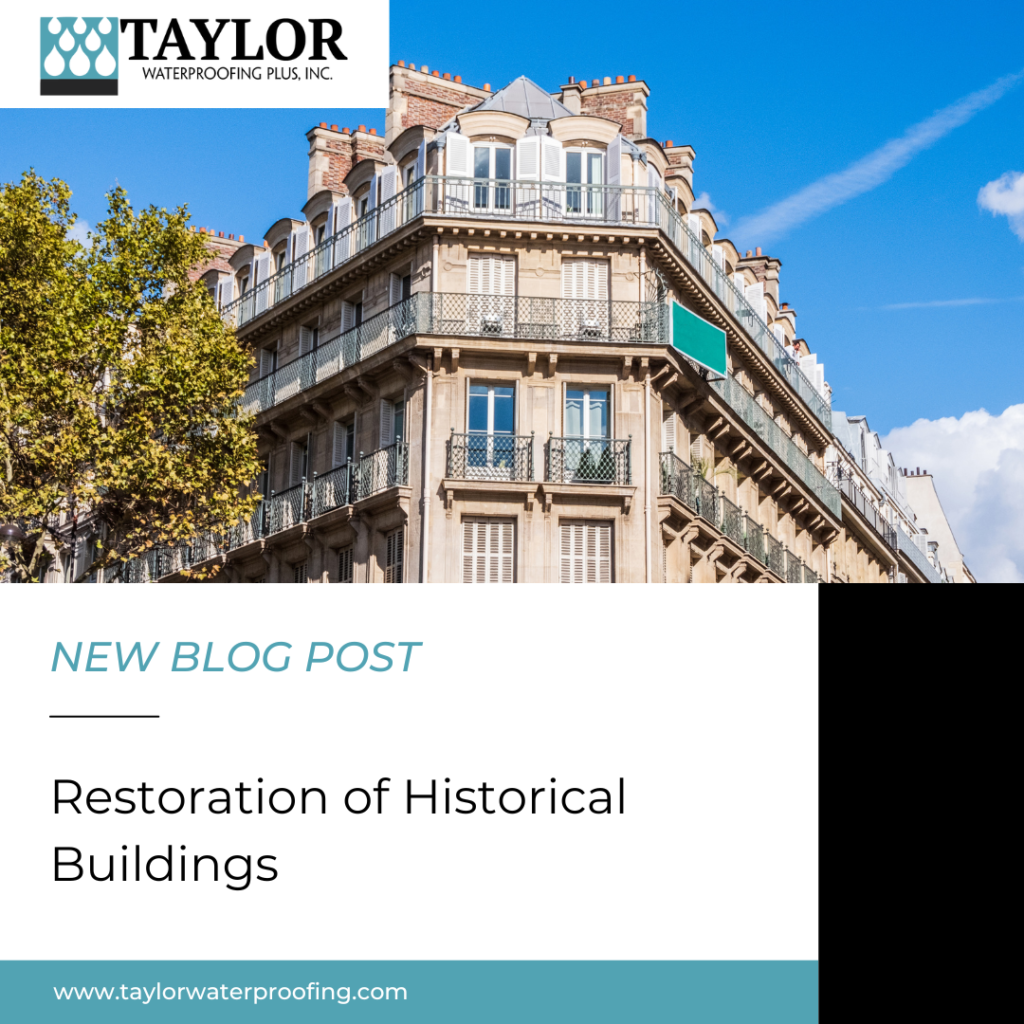
Restoration of Historical Buildings
Restoration of historical buildings is a necessity to preserve their structural integrity and the history associated with the building. This needs to be done with special attention and care to prevent further damage from occurring. Taylor Waterproofing’s team of professionals specializes in building preservation and has the knowledge to restore historical buildings to what they once were.
Techniques for Restoration
Sandblasting: Sandblasting is a useful technique for restoration, especially for brick buildings that may have been painted over throughout the years. Sandblasting helps restore a historical brick building to its former glory.
Waterproofing Services: Over time, roof leaks can damage older, historical buildings. Waterproofing is essential to preserve wooden structures and prevent them from rotting or molding due to a build-up of moisture. Taylor Waterproofing will work with you to create a solution that assists in restoring any historical building.
Brick Repair: Brick is a sturdy material used in the construction of many historic buildings. However, over time, water and other factors can cause corrosion. Our brick repair services are ideal for historic buildings, as we aim to preserve the overall appearance and structural integrity of the building. Sealants can also be applied to brick to preserve them and prevent further corrosion from occurring.
Elastomeric Coatings: Elastomeric coatings are especially useful for the restoration of historical buildings, as it is a coating that waterproofs and seals the exterior of a building, preventing further damage. This coating is used for roofing, paint coating, and protecting masonry. It is an ideal method to protect historic buildings from rain, wind, temperature fluctuations, and damage from the sun.
All in all, Taylor Waterproofing is committed to the restoration of historical buildings and preserving the history attached to them. We offer many services that protect these pieces of history and keep them structurally sound for years to come. For more information about our historical restoration services contact us on our website here. For more waterproofing tips and information, check out our blog here.

